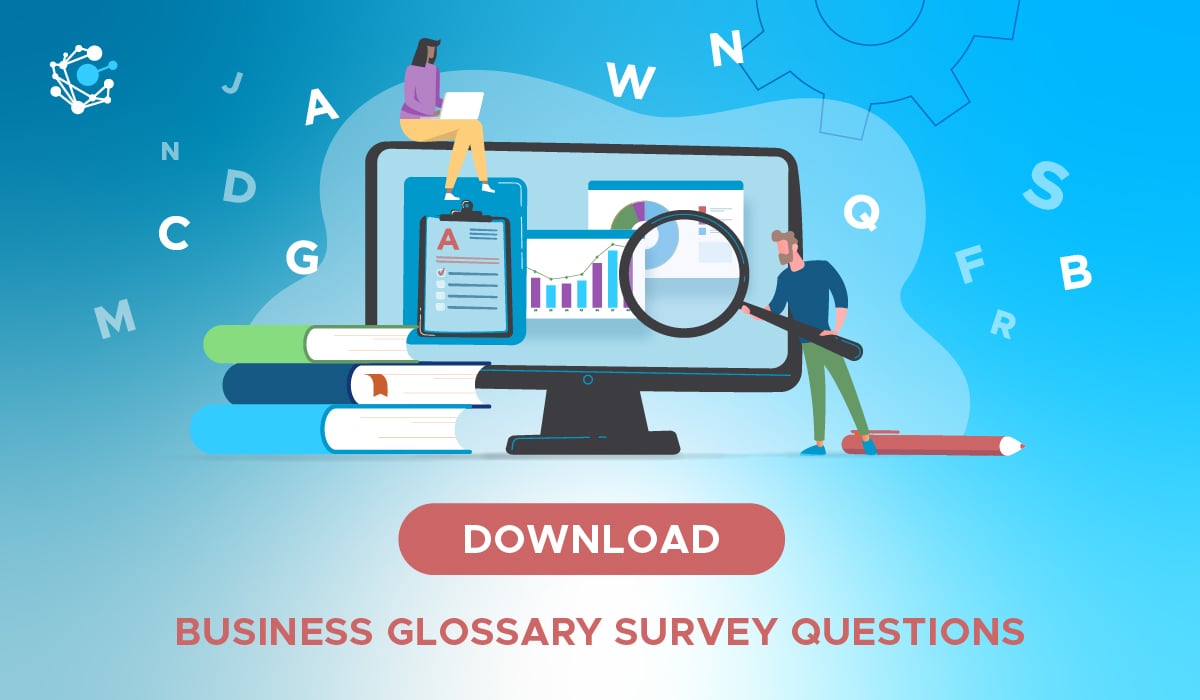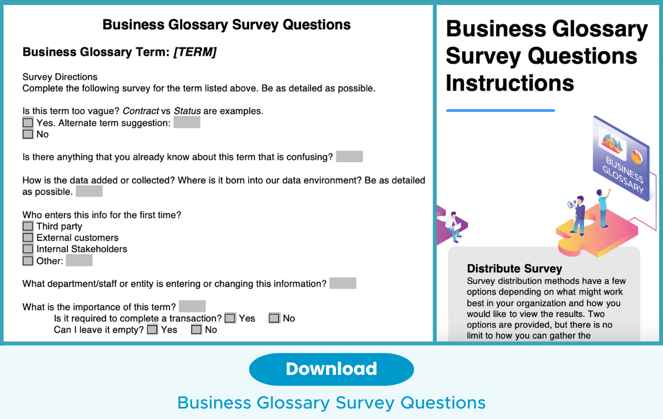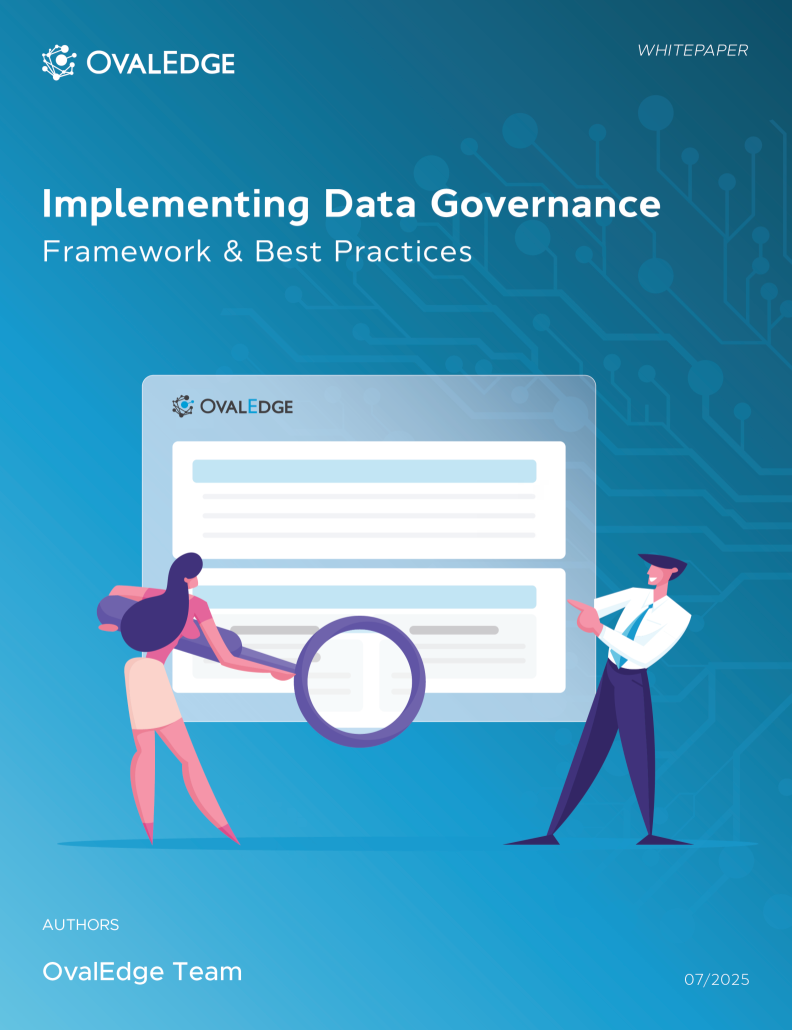Table of Contents
Data Governance Business Glossary For Trusted Terms
A data governance business glossary is an essential data literacy tool and crucial for understanding the data in your organization and undertaking effective analytics. Without a business glossary, companies are often overwhelmed by the sheer number of conflicting terms and definitions used. When there is no standardization, organizations will encounter hurdles that impede critical business processes, across the board.
A business glossary enables users to find common terms and definitions, collaborate more easily on data assets, and move forward fluidly with data-driven growth initiatives. It’s not easy to build a business glossary, and you’ll need a dedicated tool to help you with the process, but by the time you finish this article you’ll have a clear vision on how to progress.
Read on to learn how to create a business glossary and implement the resource into your organization using the right technology for your needs.
When trying to identify which terms to prioritize for your business glossary, methods such as analyzing usage and technical importance are sometimes unavailable. Instead, you can create a survey to find which terms are important to your organization. Use the survey questions provided to get a robust picture of important terms that need defining through data governance. Don't be afraid to add your own questions!
Click to Download our Business Glossary Survey Questions
What is a Business Glossary?
A business glossary pulls together data-related terms and definitions and displays them clearly and logically so everyone in an organization can access them. Standardization is one of the most significant components of data literacy and is the key driver of developing a business glossary in any organization.
The trouble is, it is easy to come up with a definition but difficult to coordinate with multiple individuals and departments to establish common terms from the get-go. That's why individual users and departments tend to adopt conflicting terms.
Over time, as more and more terms are used, a company’s data assets become very difficult to navigate, making it almost impossible for users to collaborate and innovate using data assets they are unfamiliar with. A business glossary clears up this confusion by introducing standardized terms and definitions that everyone in an organization can understand.
Simply, A business glossary serves as a centralized repository of standardized business terms, definitions, and metadata, acting as a single source of truth across departments to eliminate ambiguity and ensure consistent data interpretation. It documents usage, authoritative sources, quality rules, and ownership for key terms. Visit for detailed solution OvalEdge Data Governance Solutions
What are the Elements of a Business Glossary?
Although a business glossary has the core goal of standardizing terms in an organization, there are many elements and use cases that constitute it. These include:
- Terms and definitions - so business users can benefit from consistency and gain a better understanding of data assets quickly and easily
- Data classification - so users can search for, identify, and find relationships amongst data based on how it has been classified
- Reference data - so data governance groups can categorize data at a micro-level
- Technical metadata - so experienced data analysts can analyze data assets in the context
However, it is vital to note that every organization will have specific use cases that they wish to fulfill by implementing a business glossary. Even if you only identify with one or two of the elements we have covered above. The likelihood is, there will be more that are specific to your company.
Business Glossary is often confused with, but NOT…
Many users may find it difficult to distinguish between a business glossary and a data dictionary. However, although the two are similar, they are not the same resource.
In short, the role of a business glossary is to define terms so users can easily identify and collaborate using them. On the other hand, a data dictionary is designed to enable the smooth operation of databases by setting and enforcing various data standards, and documenting origins, formats, and relationships.
Some users may also confuse a business glossary with a data catalog. Again, although there are some similarities, there are significant differences too. Essentially, a data catalog supports the creation of a business glossary.
As we will cover in greater detail later on in this article, a data catalog crawls all of a company’s data sources and consolidates these data assets in a centralized, searchable database. It is this consolidation that makes it easy for data teams to find conflicting terms and definitions.
Business Glossary in Data Governance
Business glossary in data governance forms the foundation by aligning business and technical teams, embedding data quality rules, lineage, and stewardship directly into definitions to enhance compliance, decision-making, and regulatory reporting like GDPR.
It bridges silos, reducing errors by up to 40% through shared understanding. Visit for more information Data Governance & Compliance
Key Benefits of Having a Business Glossary
There are several crucial business benefits to establishing a business glossary in your organization. Below are the most important points.
If you want to go even further in-depth listen to my discussion with George and Diana Firican from Lights on Data, here!
1. Facilitates Understanding
With an active business glossary, users can quickly and easily find definitions for terms that make it easier to understand data sets. For example, if a business user needs to access a report from another department that includes terms unknown outside of the department, they can look up the term in the company’s business glossary.
Imagine if a business user from R&D wants to access financial records in order to streamline costs and make their annual budget stretch further. If they access data held by the finance department there are likely to be many terms used that are uncommon to them, making the task of deciphering the data almost impossible. When these terms are standardized and listed in a business glossary the whole process is made far simpler.
Related: Data Literacy: What it is and How it Benefits Your Business
2. Improves Communication Between Departments
Effective communication is crucial for data-driven innovation. A business glossary makes it easy to communicate with other departments whilst avoiding confusion about particular data terms.
For example, in the healthcare sector, there is no standard definition to calculate the “length of stay” in hospitals, something every hospital reports in its annual balance sheet. When every hospital collects data differently and calculates the length of stay differently how can this data be aggregated?
This point makes it very difficult for mergers to take place. One hospital might define the length of stay as the moment a patient enters the hospital to when they leave, while another hospital might define it as the time spent on a particular ward, or from the first meeting with a doctor.
3. Reduces Operational Complexity and Confusion
A business glossary addresses operational issues from the top down. Without this tool in place, deciphering conflicting terms can be incredibly time-consuming, expensive, and impactful on every department.
When terms are standardized, the inconsistencies diminish and everyone can access and use data more efficiently.
This alleviates pressure from the data team because they aren’t responsible for working out the relationships and definitions of conflicting data terms. In turn, the day-to-day operation of a business is streamlined, from a data perspective.
4. Increases Productivity and Trust
When users trust data they are more likely to use it to make better, more productive business decisions. However, when there are conflicting terms used in an organization, users not only avoid accessing data assets, they fail to understand what they are actually accessing.
A business glossary clarifies these issues and also takes the pressure off data teams because business users can access this information independently through self-service. The result is productivity gains, company-wide.
For example, if a user decided to access customer data related to their department and makes a concerted effort to improve service, they may well be put off when the data they find is full of conflicting information. Standardizing terms makes it easier for users to become data literate because the information they need is clearly defined. The result is more innovation using company data assets.
5. Establishes Ownership
A key aspect of data governance is identifying data owners and establishing responsibility for data assets. This has several critical outcomes. When you know who the data belongs to you can contact data custodians directly and gain access to the data more quickly.
When users know they are responsible for data they can work to ensure its quality on an ongoing basis, which is ultimately beneficial for an entire organization. Thirdly, establishing data ownership makes data assets easier to categorize and organize. A business glossary enables you to document data owners quickly and easily and update any changes to this ownership status.
Simply, Data governance business glossary improves accountability via clear ownership (stewards, SMEs), supports automated validation, and scales with AI tools for real-time updates and term attachment to assets.
In 2026, it drives 30% faster data discovery and governance maturity. Visit for detailed information Enterprise Data Catalog
How to Build a Business Glossary
The first step to building a business glossary is to ask if multiple terms are in use. The ideal scenario is one where standard terms already exist, but this is usually not the case. When different departments are using different terms and definitions to explain the same thing, a bottom-up approach is required.
1. Create a Data Governance group
Businesses using a bottom-up approach need to create a data governance group. The function of the group is to standardize the terms used in an organization.
2. Determine where, how, and who is using the terms
Standardizing is a huge challenge because hundreds or even thousands of reports are already using these terms. The governance group must determine where the terms are being used, how the terms are being used, and who is using them.
3. Identify and consolidate
Through analysis, you can identify and consolidate the most critical terms in your organization.
4. Standardize terms and definitions and input them into your business glossary
Once you get this information, you need to coordinate with the users of these terms to determine a standard definition through consensus. Finally, you need to make everyone in your company aware of the new standard terms and definitions and input them into your business glossary.
Moving forward, whenever a new data element is added, it should be signed off by the governance group which will create a standard definition.
Read: What is a Business Glossary? Also, download the Business Glossary Template
If you have no existing data terms and definitions in an organization, you can adopt a top-down approach to building a business glossary. When there are no conflicting terms and definitions in use, the process of building a business glossary is far easier.
- As before, you need to set up a data governance group that includes top-level management and key stakeholders.
- The governance group will identify the terms that are likely to be used in the organization, finalize the definition of these terms, and then add them to the business glossary. Again, these decisions need to be socialized so everyone in the organization is aware of them and has access to them.
- Whenever a user wishes to use a specific term, they should access the business glossary, and use the standard definition that is there.
Unfortunately, most organizations are not in this position. There are likely to be different terms in use, especially if the company is going through a period of merger and acquisition.
Related: Building an Effective Data Governance Framework
Building Business Glossary Best Practices
Implement business glossary through prioritized high-impact terms, cross-functional governance (owners, stewards), metadata capture (rules, lineage), and platforms for collaboration.
Regular reviews ensure relevance amid evolving regulations. Visit for more information Data Observability Guide
Consider Automated Business Glossary Tools
By far the best way to implement a business glossary is through the use of an automated data governance tool. In fact, in organizations that must commit, as most will, to a top-down implementation approach, the process is almost impossible if you fail to do so.
The minimal costs of implementing a data catalog far outweigh the time and money spent attempting this rigorous process manually.
A comprehensive data catalog, like OvalEdge, includes all the tools you require to set up a business glossary in your organization. It uses AI to find, index, and summarize all of the data assets in your organization so when it comes to building a business glossary you have all of the information you need at your fingertips.
The role of adopting a data catalog is best left to the data governance group. The data catalog crawls all the reports in an organization, finds the terms, and catalogs them, whilst also building relationships between conflicting definitions.
Using a data catalog, you can quickly identify the core data owners and stakeholders in your organization. Without a data catalog, the process is unlikely to work because conflicting terms are created and updated continually.
Conclusion
Building a business glossary is essential if you want to encourage data-driven decision-making across your organization. Usually, there will be multiple terms and definitions in use, and the process is somewhat complicated. That’s why it’s essential to initiate a data catalog to make the process run more smoothly.
The responsibility of creating a business glossary falls to your data governance group. Because of this, the people you choose to join the group must be representatives of stakeholders from across your organization. One of the most significant barriers to implementing a successful business glossary is individual or departmental bias. For this reason, you must have a data governance group that represents everyone in your organization.
FAQs
-
What is a business glossary?
A centralized collection of standardized business terms, definitions, and rules for consistent organizational data understanding. -
Why is business glossary essential in data governance?
It ensures data consistency, quality, stewardship, and compliance by aligning teams on definitions and usage. -
How does a business glossary differ from a data dictionary?
Business glossary focuses on business terms; data dictionary covers technical details like data types and structures. -
What are best practices for building a business glossary?
Prioritize key terms, assign ownership, embed quality rules, and use collaborative tools for maintenance. -
How does business glossary support regulatory compliance?
Provides documented definitions and lineage for audits, proving adherence to data policies and privacy laws.
Book a call with us to find out:
|
OvalEdge recognized as a leader in data governance solutions
.png?width=1081&height=173&name=Forrester%201%20(1).png)
“Reference customers have repeatedly mentioned the great customer service they receive along with the support for their custom requirements, facilitating time to value. OvalEdge fits well with organizations prioritizing business user empowerment within their data governance strategy.”
.png?width=1081&height=241&name=KC%20-%20Logo%201%20(1).png)
“Reference customers have repeatedly mentioned the great customer service they receive along with the support for their custom requirements, facilitating time to value. OvalEdge fits well with organizations prioritizing business user empowerment within their data governance strategy.”
Gartner, Magic Quadrant for Data and Analytics Governance Platforms, January 2025
Gartner does not endorse any vendor, product or service depicted in its research publications, and does not advise technology users to select only those vendors with the highest ratings or other designation. Gartner research publications consist of the opinions of Gartner’s research organization and should not be construed as statements of fact. Gartner disclaims all warranties, expressed or implied, with respect to this research, including any warranties of merchantability or fitness for a particular purpose.
GARTNER and MAGIC QUADRANT are registered trademarks of Gartner, Inc. and/or its affiliates in the U.S. and internationally and are used herein with permission. All rights reserved.




.webp)


